Hover over images for detail:
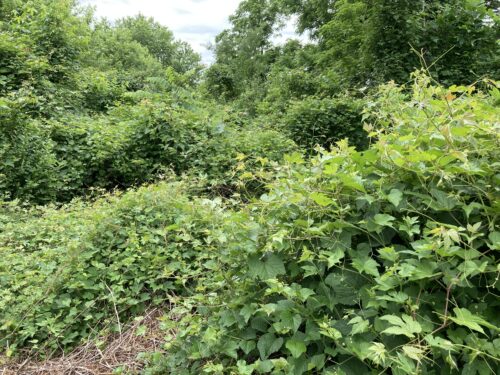 Trees and shrubs are smothered by porcelain-berry vines
Trees and shrubs are smothered by porcelain-berry vines
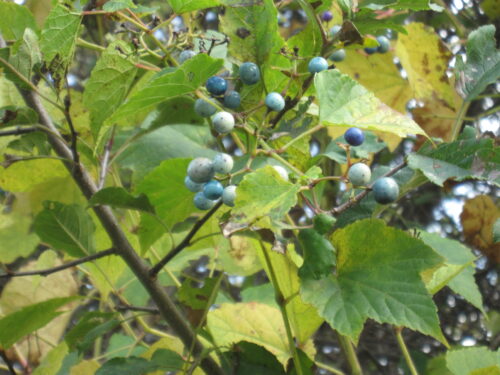 To view the gravity of this invasive vine, go to the Carpenter Farm Park Restoration page.
To view the gravity of this invasive vine, go to the Carpenter Farm Park Restoration page.
Porcelain-berry in early autumn
Although porcelain-berry has overwhelmed a park in Cincinnati, Ohio, this vine is a relatively new invasive on Long Island. It is similar in appearance to our New England grape with twining tendrils and nodes along the vine, except that the pith (center of the vine) of porcelain-berry is solid white; its mature bark often separates from the pith; the woody vines are very flexible; the berry colors may be white, yellow, lilac, turquoise, green or pink, eventually turning dark blue; the leaves are generally smaller than grape, with deep lobes; and the best indicator: the underside of the porcelain-berry leaf is always glossy.
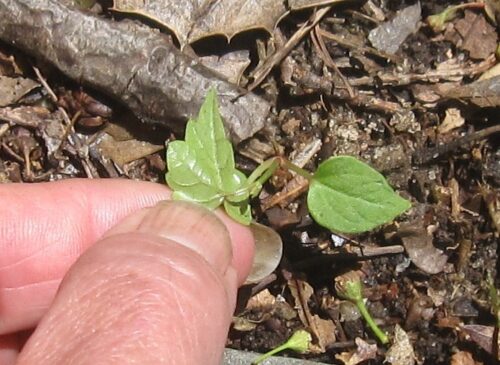 The leaf at the right is one of two cotyledons. The underside of true porcelain-berry leaves is glossy.
The leaf at the right is one of two cotyledons. The underside of true porcelain-berry leaves is glossy.
While the first two small leaves (cotyledons), which emerge from the seed, are egg-shaped with a tapering point and widest near the petiole or stem, the first true leaves resemble New England grape, but for the glossy underside.
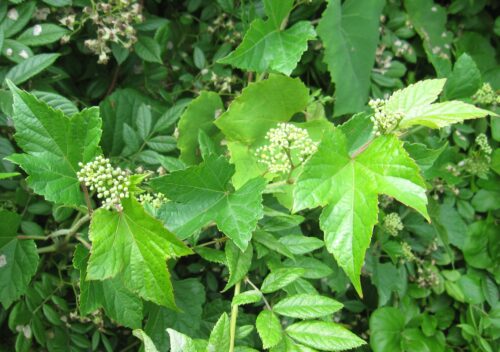 Porcelain-berry flowers in late spring
Porcelain-berry flowers in late spring
When vines are cut above ground, they may be placed on a tarp or left in a tree or shrub to dry. However, by summer, once in bloom or with berries, the vines must be removed and bagged. We stuff them into empty 50 lb. animal feed bags, stapled closed for trash collection.
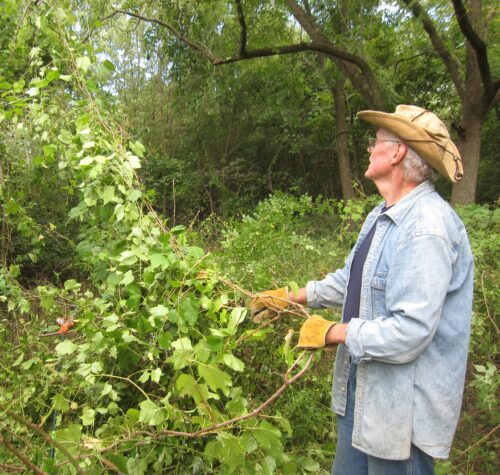 Pulling porcelain-berry vines from a tree in late summer
Pulling porcelain-berry vines from a tree in late summer
Tendrils, which twist around branches and stems of the supporting trees, shrubs, tall grasses, and herbaceous plants, should be cut with pruners to release the vine without damaging the host plant. Multiflora rose shrubs, typically found beneath a cover of porcelain-berry, should be uprooted or cut down at or below the ground level.
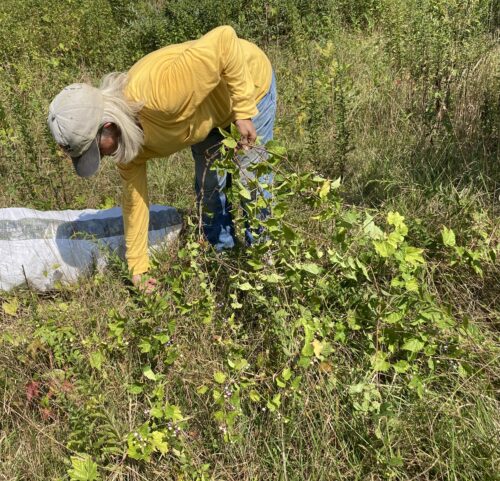 Cutting several vines together at the ground
Cutting several vines together at the ground
When possible, trace back to where one vine emerges from the root crown (hub) and simultaneously cut and pull up all the porcelain-berry vines found there. (Read further to learn how to slice a root crown to remove all the vines and prevent new growth with one cut.) Be careful not to mistakenly cut native vines such as Virginia creeper. Typically, Japanese honeysuckle and Oriental bittersweet vines will grow alongside porcelain-berry and should also be cut at the ground or uprooted. Whenever in bloom or with berries, dispose of all vines in the trash.
While cutting vines at the ground is the first step to achieving control, young porcelain-berry vines may be uprooted with the appropriate method shown below.
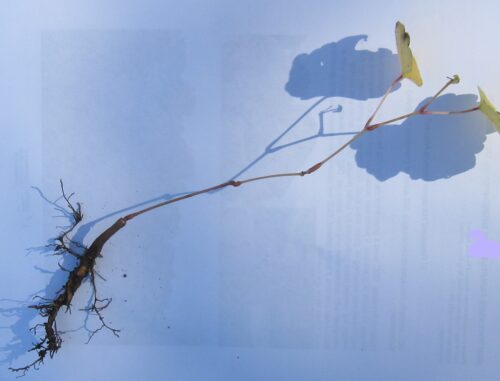 Young porcelain-berry root
Young porcelain-berry root
Young vines thicken an inch or so above the ground. These vines are easily removed by grabbing low on this thickened portion by hand with a leather glove for traction or with a pair of linesman’s 8-inch pliers, using a back-and-forth pulling with a jerky motion, ideally in damp soil while visualizing the root as it releases. If the vine snaps off at the ground it indicates it is breaking off from an older root crown or a lateral root, which should be cut or “sliced” as described below.
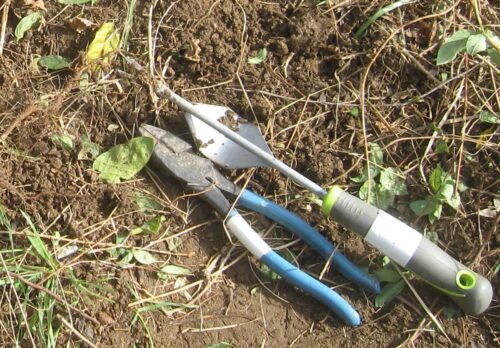 For seedlings or young plants, use large linesman’s pliers along with a leveraged hand weeder to loosen dry soil
For seedlings or young plants, use large linesman’s pliers along with a leveraged hand weeder to loosen dry soil
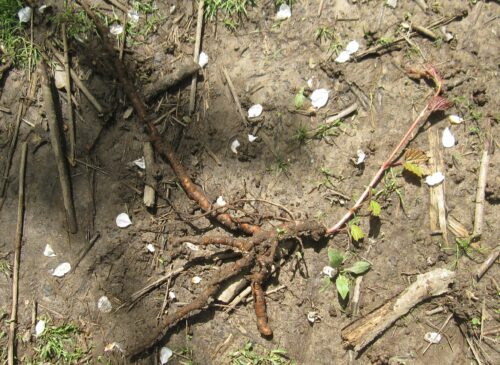 Older porcelain-berry root crown with lateral roots and a small vine
Older porcelain-berry root crown with lateral roots and a small vine
At the next growth stage, the thick portion becomes the root crown, which should be dug out when young– using a leveraged hand weeder for small roots, or with a shovel, pick-axe, mattock, or Pulaski axe for larger roots. Then the exposed crown may be extracted with large pliers or a weed wrench, or cut with loppers, and the lateral roots extracted as much as possible. Be aware, however, each lateral remaining in the ground may grow a new set of vines, a root crown, and more lateral roots.
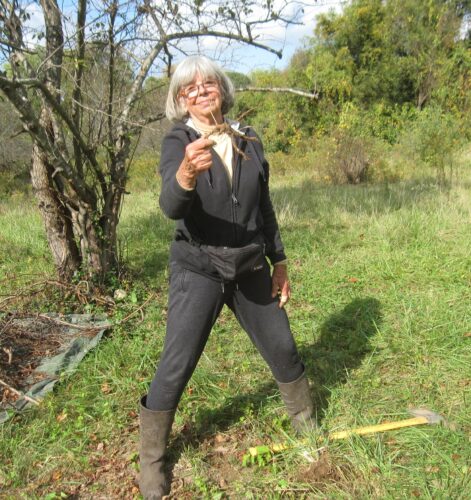 A Pulaski axe was used here
A Pulaski axe was used here
Eventually, you’ll notice that the vines emerge from the top and the sides of the root crown. You’ll also notice that the rubbery lateral roots emerge from the lower half of the root crown. Now, if you were to slice the crown horizontally through the middle, you might conclude that the vines will die without their roots, and the roots will die without their vines. While that’s true for the vines from the upper half of the severed crown, new vines will grow from any bark around the edge of the lower half of the crown, which remains in the ground. Therefore, it’s important to scrape off all the remaining bark, exposing the white center pith of the crown, which is dead wood and can’t support vines. Once sliced, cover the remaining root crown with soil and press down. Decay organisms will then rot the wood.
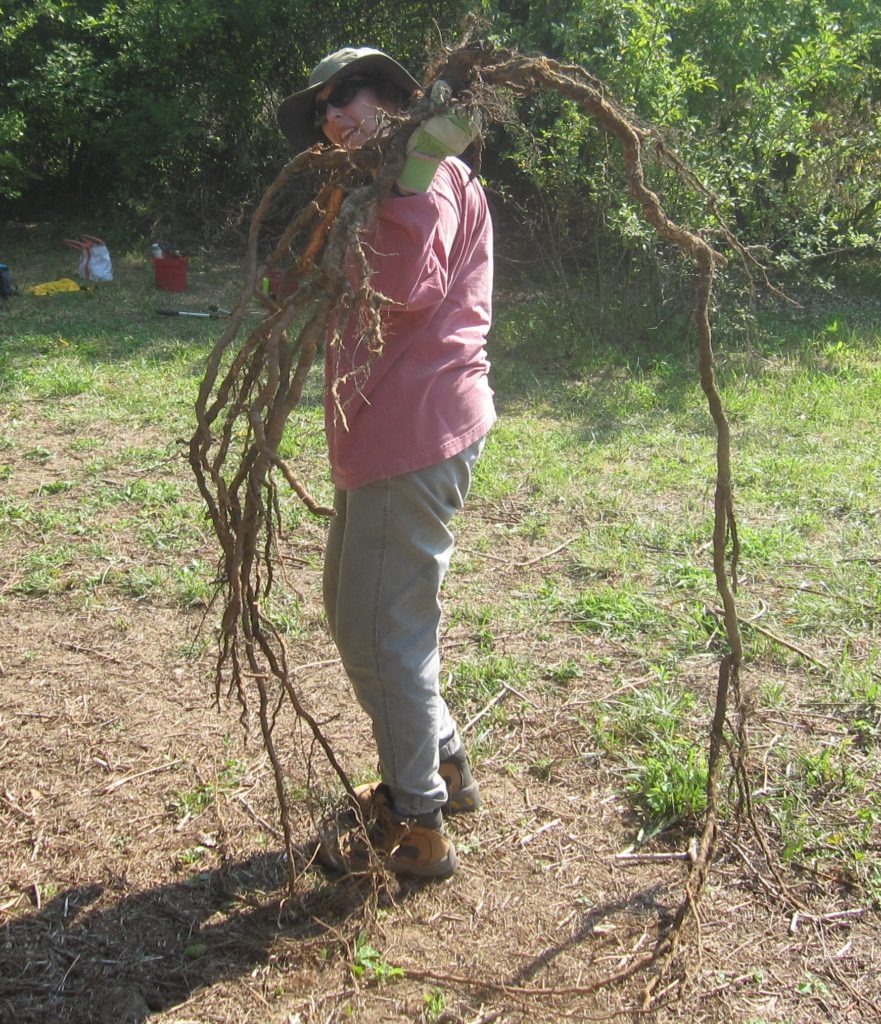 12-foot root of porcelain-berry vine with root crown at Kate’s shoulder
12-foot root of porcelain-berry vine with root crown at Kate’s shoulder
The lateral roots are reddish brown, knotty/rubbery, and the root bark easily separates from the core or pith. All severed parts of the roots must be allowed to dry above ground or safely bagged/discarded, and the site routinely monitored. If the plant in the above photo had been sliced at the root crown, it would have saved time spent on extracting the roots.
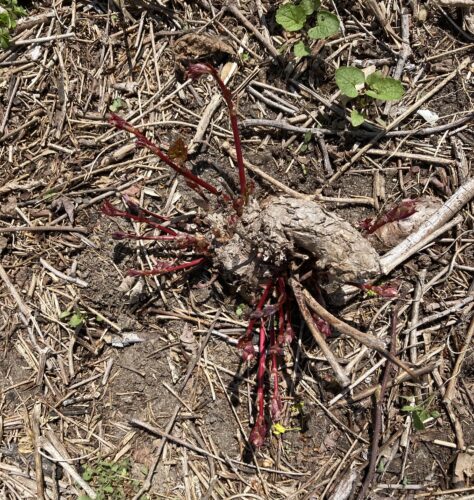 New red vines from a root crown in April after cutting this large vine 2 inches above the ground the previous year.
New red vines from a root crown in April after cutting this large vine 2 inches above the ground the previous year.
To recap: during a winter thaw, you may dig out the root crown with a pick or Pulaski axe and pull out the lateral roots as far as possible with a linesman’s pliers if needed. Click Restoration to view an invasion of this plant at a local park.
Better yet, slice the root crown with new growth at the ground, using loppers or a saw as described below.
 1) Large porcelain-berry root crown
1) Large porcelain-berry root crown
Slice larger root crowns horizontally, discard the top half, and chisel off any remaining bark from the lower half to allow the root system to die.
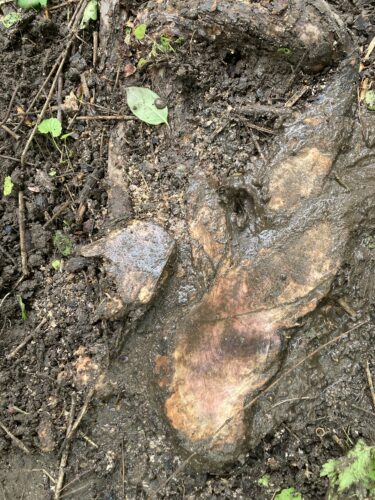 2) A sliced large porcelain-berry root crown with bark around the edge
2) A sliced large porcelain-berry root crown with bark around the edge
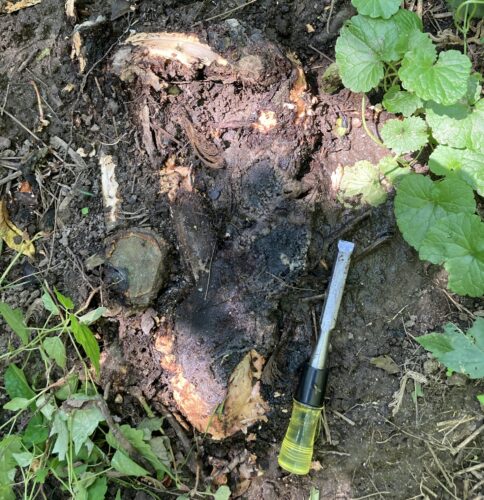 3) Bark was chiseled weeks later from where several vines began growing
3) Bark was chiseled weeks later from where several vines began growing
Root crowns may be sliced with pruners, loppers, a hand saw, or a reciprocating limb saw. To prevent new vines from growing, any remaining bark must be removed from the white inner pith, using pruners or a chisel.
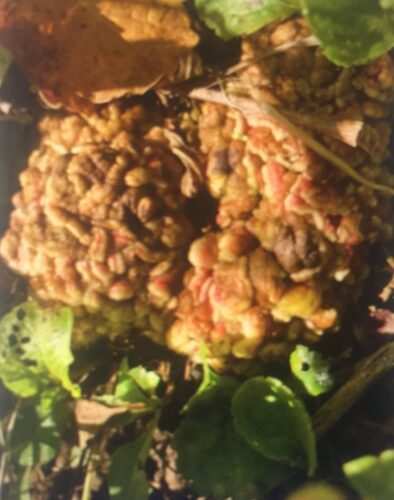 Wart-like growth on the sliced root crown
Wart-like growth on the sliced root crown
We discovered growths on the bottom half of the root crowns that had been sliced horizontally at the ground. This is done to expose the inner pith and to separate the vines from the remaining roots to die underground. The wart-like growth is a bacterial gall, which lives in the soil and attacks these woody vines in warm weather, killing the intact root system. And in cooler temperatures, the root system dries.
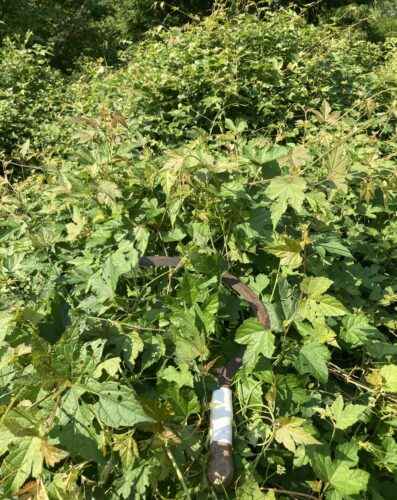 Early July Mounds of Porcelain Berry and Hand Sickle
Early July Mounds of Porcelain Berry and Hand Sickle
Once porcelain berry vines grow out of control, the way to determine where the vines originate is to grab as many vines in one hand and cut them out with a sickle with the other hand until the ground is visible. Then find and slice the root crowns beneath. By July, the cuttings with berries must be bagged and disposed of.
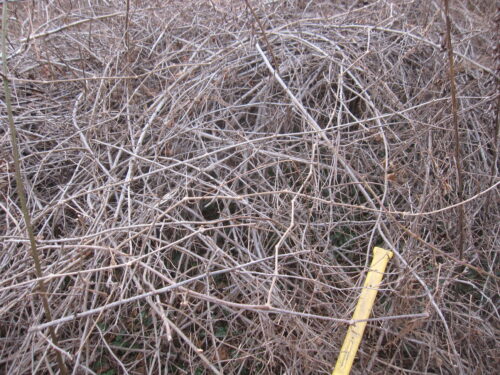 Zig-zag porcelain-berry vines in winter
Zig-zag porcelain-berry vines in winter
Older porcelain-berry vines can be identified in mid-winter by the straw-colored zigzag vine with curly tendrils at the nodes.
Porcelain-berry vines are deciduous. And since they drop their leaves in late fall, they are easily spotted alongside high-trafficked roads.
And yes, our spotted lanternfly insects may be found on porcelain-berry vines, since they are in the grape family, their favorite snack.
